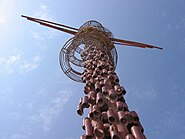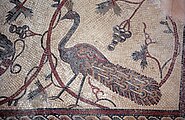
Mount Nebo, seen from east at a distance from 1,4 km
Mount Nebo (Arabic: جبل نيبو, Jabal Nibu. Hebrew: הַר נְבוֹ, Har Nevo, ) is an elevated ridge that is approximately 817 meters (2680 feet) above sea level, in what is now western Jordan. The view from the summit provides a panorama of the Holy Land and, to the north, a more limited one of the valley of the River Jordan. The West Bank city of Jericho is usually visible from the summit, as is Jerusalem on a very clear day.
Religious significance[]
Judaism and Christianity[]
According to the final chapter of Deuteronomy, Mount Nebo is where the Hebrew prophet Moses was given a view of the promised land that God was giving to the Israelites. "And Moses went up from the plains of Moab to Mount Nebo, the top of Pisgah, which is opposite Jericho." (Deuteronomy 34:1).
According to Jewish and Christian tradition, Moses was buried on this mountain by God Himself, and his final resting place is unknown. Scholars continue to dispute whether the mountain currently known as Nebo is the same as the mountain referred to in the Torah.
According to the 2 Maccabees 2:4-7, the Prophet Jeremiah hid the tabernacle and the Ark of the Covenant here.
Ruins[]
On the highest point of the mountain, Syagha, the remains of a church and monastery were discovered in 1933. The church was first constructed in the second half of the 4th century to commemorate the place of Moses' death. The church design follows a typical basilica pattern. It was enlarged in the late fifth century A.D. and rebuilt in A.D. 597. The church is first mentioned in an account of a pilgrimage made by a lady Aetheria in A.D. 394. Six tombs have been found hollowed from the natural rock beneath the mosaic-covered floor of the church. In the modern chapel presbytery, built to protect the site and provide worship space, you can see remnants of mosaic floors from different periods. The earliest of these is a panel with a braided cross presently placed on the east end of the south wall.
Recent history[]
On March 20, 2000, Pope John Paul II visited the site during his pilgrimage to the Holy Land (Mount Nebo being one of the most important Christian sites in Jordan). During his visit he planted an olive tree beside the Byzantine chapel as a symbol of peace.
Pope Benedict XVI visited the site on May 9, 2009, gave a speech, and looked out from the top of the mountain in the direction of Jerusalem.
The serpentine cross sculpture (the Brazen Serpent Monument) atop Mount Nebo was created by Italian artist Giovanni Fantoni. It is symbolic of the bronze serpent created by Moses in the wilderness (Numbers 21:4-9) and the cross upon which Jesus was crucified (John 3:14).
A recently released book "Temple at the Center of Time" by author David Flynn, claims evidence has been found that the Ark of the Covenant is hidden at Mount Nebo.
See also[]
External links[]
| Wikimedia Commons has media related to: Mount Nebo (Jordan) |
- Franciscans at Mount Nebo
- Photographs of excavations in Jordan at Archaeology and Art
- Pictures from mount Nebo 1
Gallery[]

Mount Nebo, view to north east
Coordinates: 31°46′04″N 35°43′31″E / 31.76778°N 35.72528°E
Some or all of this article is forked from Wikipedia. The original article was at Mount Nebo (Jordan). The list of authors can be seen in the page history.













